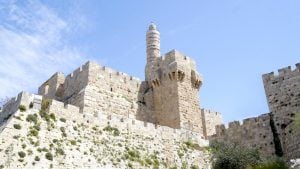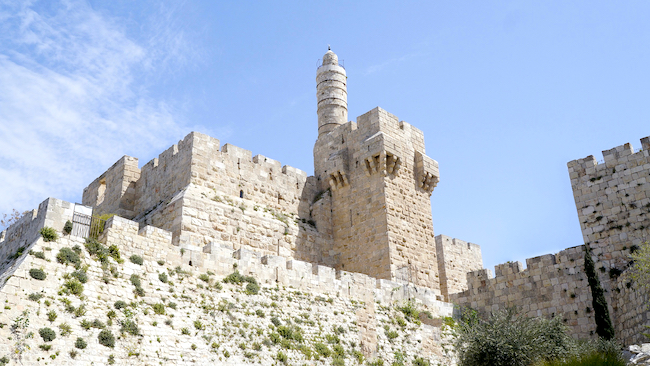
M’lochim 1 5:26
This week’s haftorah teaches us an important perspective about the Holy Temple and our synagogue. The haftorah opens with a detailed account of Shlomo Hamelech’s construction of the Bais Hamikdash. He engaged nearly two hundred thousand workers in hewing and transporting scarce heavy stones for the Bais Hamikdash’s foundation. He built its exterior walls from perfectly hewed stones from the quarry that did not require any cutting or planing. He enhanced the basic structure with numerous chambers, annexes and winding staircases and paneled the entire structure with impressive cedar wood.
In the midst of this heavy construction Hashem sent Shlomo Hamelech a prophetic message and stated, “(Regarding) The house you are building, if you walk in My statues, adhere to My laws and guard all My mitzvos …. I will dwell amongst the Jewish people and not forsake My nation, Israel.” (M’lochim I 6:12,13) Hashem told Shlomo Hamelech at the outset that the expressed purpose for all his labor was to create an earthly abode for Hashem. The impressive architectural structures, jewel studded walls and gold trimmings would not secure this objective. The sole factor in this would be guarding Hashem’s statutes and carefully adhering to all His mitzvos. Hashem declared that the entire value of this magnificent edifice depended upon the Jewish people. If they sincerely desired to unite with Him they would merit His Divine Presence. Hashem pledged to remain amongst them as long as they displayed true desire to be with Him.
Malbim notes the juxtaposition of this prophecy in the midst of the construction. Scriptures indicate that Shlomo received this prophecy upon completing the Bais Hamikdash’s exterior before beginning its interior. Malbim sees this moment as a transitional point in the building process, a time most appropriate for this prophecy. We can appreciate Hashem’s timely message through S’forno’s insightful comment about the Sanctuary and the Holy Temple.
The Sages inform us that the actual Sanctuary remained perfectly intact and never fell into foreign hands. When King Yoshiyahu foresaw the Jewish nation’s exile he secretly buried the Holy Ark, the Sanctuary and many of its holy vessels in a cave below Yerushalyim for preservation. The first Holy Temple did not merit such fortune and aside from suffering much deterioration ultimately fell into wicked Babylonian hands who leveled the entire magnificent edifice. This digression continued and the second Temple did not even merit to house Hashem’s intense Divine Presence within its walls.
S’forno informs us the reason for such contrasting experiences with these sacred structures. He sees the key factor in this as the pious nature of individuals involved in erecting these structures. The Sanctuary was built by pious, devout individuals totally focused on creating an earthly abode for Hashem. Moshe Rabbeinu oversaw the entire construction devoting himself to the perfect fulillment of every detail. Hashem’s devout Levites had a major hand in the construction under the leadership of Ahron Hakohain’s son, Isamar. The project’s contractor was Betzalel gifted with sacred insights to the Heavenly process of creation. The holy structure they constructed did not allow for deterioration or destruction and demanded eternal preservation.
Conversely, the first Temple’s construction shared only some of these experiences. Although the pious Shlomo Hamelech oversaw its construction his massive undertaking included multitudes of skilled craftsmen from Tyre. These foreign workers did not relate to spirituality value and failed to dedicate their every act towards that end. Although Hashem rested His intense presence in the first Temple this sacred edifice was not spared from deterioration and destruction. The second Temple was not even overseen by devout, pious individuals. Hashem’s Levites were not involved in its construction and the bulk its workers were of foreign decent. In fact, the second Temple did not even merit the return of the holy Ark and Hashem’s Divine Presence was not intensely sensed within its walls. (S’forno S’hmos 38:21)
In light of the above we appreciate Hashem’s timely message to Shlomo Hamelech. After successfully completing the exterior Shlomo set his focus on the interior of the Bais Hamikdash. At that exact moment Hashem reminded Shlomo of the interior’s exclusive purpose. Hashem desired to secure the Temple for as long as possible and chose this exact moment to inspire Shlomo towards its spiritual direction. This impressive structure was to serve as Hashem’s earthly abode provided His people display true desire to unite with Him. After Shlomo received his charge he immediately focused on the project’s Divine dimensions and dedicated every detail of the interior to Hashem. Shlomo hoped to create through this Hashem’s permanent earthly abode. Although other factors interfered with Shlomo’s noble goal, his efforts were fruitful. Unlike the second Bais Hamikdash, Shlomo’s Bais Hamikdash merited Hashem’s intense presence for four hundred and ten years. The awesomeness of this experience is best expressed through the Vilna Gaon’s classic reflection. He once commented that he could not even fathom the spiritual capacity of the ordinary Jew of those times who merited to enter the Bais Hamikdash and stand in Hashem’s sacred presence.
This lesson in construction and devotion equally applies to our miniature Bais Hamikdash, our synagogue. HaRav Chaim of Volozhin shared with us the potential sanctity of our synagogue. He said, “Imagine what would result in one devoted his thoughts when chopping the wood for the handle of the ax used to chop the wood for the walls of a synagogue. If every detail of construction was devoted towards housing Hashem’s Divine presence the following result would undoubtedly result. The sanctity within its walls would be so intense that it would be virtually impossible to engage there in idle chatter. Indeed, even our present day synagogue has potential for true sanctity. When we construct a house for Hashem totally for His sake it will also merit everlasting spiritual status. Although majestic interior contributes to the beauty of our Bais Haknesses its endurance and spiritual capacity does not stem from this. The singular factor is our focus on the Divine Presence residing therein. When we construct our miniature Temple in this manner it will undoubtedly merit intense degrees of sanctity and forever remain the home of Hashem.
Although such conditions are difficult to meet in full we can do our part to preserve the sanctity of our sacred synagogues. Even in our times Hashem desires to rest amongst His people. Our humble synagogue can facilitate this goal when shown its proper respect. If we pause before entering this sacred edifice and contemplate who rests within its walls we would merit to sense, in some way, His Divine presence. If we could devote sincere effort towards preserving our synagogue’s sanctity we would be overwhelmed by Hashem’s intense presence sensed therein. May we soon merit Hashem’s full return to His people and may we be privileged to stand in His sacred presence forever.
Text Copyright © 2002 Rabbi Dovid Siegel and Project Genesis, Inc.
The author is Rosh Kollel of Kollel Toras Chaim of Kiryat Sefer, Israel.


